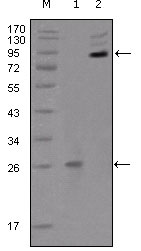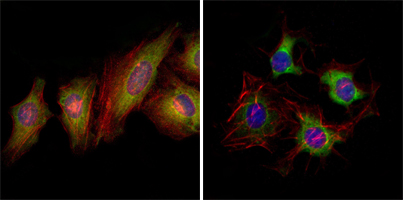EphB2 Monoclonal Antibody
- Catalog No.:YM0230
- Applications:WB;IF;ELISA
- Reactivity:Human
- Target:
- EphB2
- Fields:
- >>Axon guidance
- Gene Name:
- EPHB2
- Protein Name:
- Ephrin type-B receptor 2
- Human Gene Id:
- 2048
- Human Swiss Prot No:
- P29323
- Mouse Swiss Prot No:
- P54763
- Immunogen:
- Purified recombinant fragment of EphB2 (aa17-200) expressed in E. Coli.
- Specificity:
- EphB2 Monoclonal Antibody detects endogenous levels of EphB2 protein.
- Formulation:
- Liquid in PBS containing 50% glycerol, 0.5% BSA and 0.02% sodium azide.
- Source:
- Monoclonal, Mouse
- Dilution:
- WB 1:500 - 1:2000. IF 1:200 - 1:1000. ELISA: 1:10000. Not yet tested in other applications.
- Purification:
- Affinity purification
- Storage Stability:
- -15°C to -25°C/1 year(Do not lower than -25°C)
- Other Name:
- EPHB2;DRT;EPHT3;EPTH3;ERK;HEK5;TYRO5;Ephrin type-B receptor 2;Developmentally-regulated Eph-related tyrosine kinase;ELK-related tyrosine kinase;EPH tyrosine kinase 3;EPH-like kinase 5;EK5;hEK5;Renal carcinoma antigen NY-REN-47
- Molecular Weight(Da):
- 117kD
- References:
- 1. Nat Genet. 2004 Sep;36(9):979-83.
2. Pediatr Res. 2005 Apr;57(4):537-44.
- Background:
- This gene encodes a member of the Eph receptor family of receptor tyrosine kinase transmembrane glycoproteins. These receptors are composed of an N-terminal glycosylated ligand-binding domain, a transmembrane region and an intracellular kinase domain. They bind ligands called ephrins and are involved in diverse cellular processes including motility, division, and differentiation. A distinguishing characteristic of Eph-ephrin signaling is that both receptors and ligands are competent to transduce a signaling cascade, resulting in bidirectional signaling. This protein belongs to a subgroup of the Eph receptors called EphB. Proteins of this subgroup are distinguished from other members of the family by sequence homology and preferential binding affinity for membrane-bound ephrin-B ligands. Allelic variants are associated with prostate and brain cancer susceptibility. Alternative splicing results in multiple tr
- Function:
- catalytic activity:ATP + a [protein]-L-tyrosine = ADP + a [protein]-L-tyrosine phosphate.,disease:Defects in EPHB2 are involved in the development of prostate cancer metastasis to the brain [MIM:603688].,disease:Defects in EPHB2 are involved in the progression of prostate cancer [MIM:176807].,function:Receptor for members of the ephrin-B family. Acts as a tumor suppressor.,similarity:Belongs to the protein kinase superfamily. Tyr protein kinase family.,similarity:Belongs to the protein kinase superfamily. Tyr protein kinase family. Ephrin receptor subfamily.,similarity:Contains 1 protein kinase domain.,similarity:Contains 1 SAM (sterile alpha motif) domain.,similarity:Contains 2 fibronectin type-III domains.,subunit:The ligand-activated form interacts with multiple proteins, including GTPase-activating protein (RASGAP) through its SH2 domain. Binds RASGAP through the juxtamembrane tyrosi
- Subcellular Location:
- Cell membrane; Single-pass type I membrane protein. Cell projection, axon . Cell projection, dendrite .
- Expression:
- Brain, heart, lung, kidney, placenta, pancreas, liver and skeletal muscle. Preferentially expressed in fetal brain.
- June 19-2018
- WESTERN IMMUNOBLOTTING PROTOCOL
- June 19-2018
- IMMUNOHISTOCHEMISTRY-PARAFFIN PROTOCOL
- June 19-2018
- IMMUNOFLUORESCENCE PROTOCOL
- September 08-2020
- FLOW-CYTOMEYRT-PROTOCOL
- May 20-2022
- Cell-Based ELISA│解您多样本WB检测之困扰
- July 13-2018
- CELL-BASED-ELISA-PROTOCOL-FOR-ACETYL-PROTEIN
- July 13-2018
- CELL-BASED-ELISA-PROTOCOL-FOR-PHOSPHO-PROTEIN
- July 13-2018
- Antibody-FAQs
- Products Images

- Western Blot analysis using EphB2 Monoclonal Antibody against truncated EphB2 recombinant protein (1) and extracellular EphB2(aa19-476)-hIgGFc transfected CHO-K1 cell lysate(2).

- Immunofluorescence analysis of Hela (left) and HepG2 (right) cells using EphB2 Monoclonal Antibody (green). Red: Actin filaments have been labeled with DY-554 phalloidin. Blue: DRAQ5 fluorescent DNA dye.



